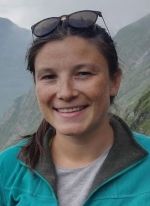Trial lecture - time and place
16. August 2019 10:15 - 11:00, Auditorium 1, The Geology building
Adjudication committee
- Professor Giorgio Pennacchioni, Department of Geoscience, University of Padova
-
Professor Lucie Tajcmanova, Institute of Earth Sciences, University of Heidelberg
-
Professor Stephanie Werner, The Centre for Earth Evolution and Dynamics, University of Oslo
Chair of defence
TBA
Supervisors
- Professor Bjørn Jamtveit, Department of Geosciences
- Professor Håkon Austrheim, Department of Geosciences
Additional information
Popular scientific article about Petley-Ragan’s dissertation:
How do earthquakes transform the roots of mountains?
Beneath mountains the continental crust can be 25-100 km thick. At such depth, the rocks that make up the roots of the mountains are expected to flow in a ductile manner over geological timescales. But there is evidence in 430 million year old rocks from Western Norway that the roots of mountains can break and generate earthquakes.

The aim of this thesis was to assess the way in which rocks break in the lower continental crust and how this is linked to the long-term ductile flow processes in rocks. It was found that permanent fracturing of the rocks after an earthquake creates space for the movement of water. The addition of water then helps the transport of chemical components required for rock-forming minerals to dissolve and new minerals to grow, a process known as metamorphism. The water-bearing minerals form a considerably weaker rock type that is able to flow in localized zones.
This thesis challenges the concept that earthquakes are confined to the upper 25 km of the continental crust. It also presents unequivocal evidence that earthquake damage precedes the water-driven metamorphism that promotes ductile flow.
Photos and other information:
Press photo: Arianne Juliette Alexandria Petley-Ragan
Additional photo: Field work in a mountain area on Holsnøy, Western Norway. Photo: Arianne Petley-Ragan
Candidate contact information: Arianne_Petley-Ragan (ResearchGate)
